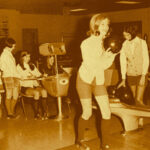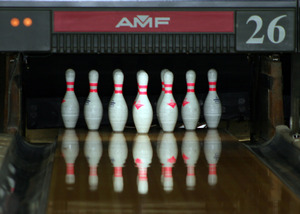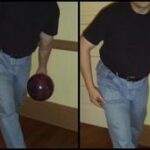“How do you make the ball turn like that?” Having spent more than 20 years in bowling centers and having bowled thousands and thousands of games, this one question is by far the most common one I get. Casual and recreational bowlers alike will often stop and stare when they see a bowler throw a shot that bends like a rainbow before obliterating the pins. It’s usually between games that the curious observer will ask me ‘the question.’
Making a ball turn, or “hook” as it’s called in bowling, has multiple benefits to the bowler. Since bowling is about knocking down as many pins as possible, bowlers should make use of every advantage that can help them accomplish that objective. Hooking a bowling ball enables the bowler to create a lot of pin action (all of those flying pins down-lane), thus increasing strike potential. When thrown with a hook, the bowling ball approaches and hits the pins at an angle. That angle of entry into the pins reduces the chance that the ball will deflect off the headpin, which can leave the center pins standing. Finally, throwing a hook gives the bowler a greater margin of error when making shots. Errant shots can work their way back to the pins with the right kind of spin on the ball. A ball thrown with no hook potential does not have the same kind of forgiveness on the lane, making a missed shot more costly in terms of score.
Now, before we get into the how-to portion of this article, let’s examine what causes a bowling ball to turn on the lane. Hooking a bowling ball is a combination of many different variables. The lanes on which the ball is thrown, the bowling ball itself, and the bowler him/herself are all factors in how much a bowling ball hooks.
Let’s first consider how the lanes affect the way a ball behaves. Bowling lanes are 60 feet long from the foul line to the head pin. Depending on the preference of the proprietor of the center, there might be oil on the first 35-45 feet of the lane. Beyond that distance on the lane, there is no oil – an area that constitutes a potential hook zone for the ball. Shorter oil (35 feet or so) generally gives the player a longer area in which to hook the ball. Longer oil (45 feet) means less hook potential due to the shorter hook zone. Many bowlers (myself included) might carry 3, 4 or even up to 8 or more bowling balls to a bowling center in order to be prepared for the various lane conditions they might face. Lanes are that important.
The construction and layout of the bowling ball probably make up 90% of the ability of a ball to hook. Modern bowling balls are constructed of complex polymers (called “reactive resin” or “proactive” covers) that are designed to absorb or deflect oil and grab the lane in the dry zone beyond the oil. Ball covers can range from ultra-slick for low hook to matte for more hook. Another element of bowling ball design is the core of the ball. Ball cores, which are odd-shaped blocks around which the ball is constructed, are designed to create a gyroscopic effect that actually causes the ball to roll over as it spins. This rollover effect (called “flare”) allows more clean ball surface to stay in contact with the lane. A ball with a well-designed core has a higher potential for flare and thus more ability to hook.
Finally, the way finger holes are drilled in a bowling ball has a lot to do with the hook potential it carries. Most bowling balls sitting on the rack in a bowling center are drilled with what is called a conventional grip. In a conventional grip, the bowler’s fingers are inserted in the ball up to the second knuckle. Conventional grip balls are hard to hook because the fingers just don’t come out of the ball quickly. As a result, the amount of spin on the ball is very low, and there is very little hook. In order to overcome this problem, bowlers at more advanced levels have their bowling balls drilled in such a way that the fingers are inserted only to the first knuckle – called fingertip drilling. This drilling enables the bowler to impart more spin, which equates to more hook.
When all else has been considered, the bowler still has to do his or her part in managing the roll on the ball. When I observe a newer bowler trying to hook a bowling ball, I generally notice that he employs a lot of arm movement as he tries to force the ball into a spin. The elbow flies away from the body in a motion we call “chicken winging,” and he yanks his arm upward. The results of such a ‘technique’ are almost always poor shots. I understand what this bowler is trying to do, but hooking a ball is definitely a case of “less is more” when it comes to achieving a good result. The less arm rotation around the bowling ball and ‘ripping’ action with the hand, the better the spin the ball achieves. Proper ball spin is in the wrist, not the arm.
Let’s assume the following: a new right-handed bowler has a new matte-finish proactive bowling ball with a fingertip drilling. He is bowling on lanes with medium oil (40 feet). If our imaginary bowler attempts to create spin (revolutions) by wrapping his arm and hand around the ball, the ball will simply spin like a top down the lane and barely turn at all. However, if our bowler were to keep his hand behind the ball, letting it roll naturally off his hand, there would be proper rotation of the ball, and it will hook once it reaches the dry part of the lane.
Think of it this way: imagine you were standing directly behind our imaginary bowler and took a snapshot of his delivery just before he let the ball go. In that snapshot, you should see that his two middle fingers are at around 7:00 on the back of the ball and not around the outside of the ball. The rest of the delivery would see the bowler straighten his wrist from 7:00 to 6:00 at the bottom of the swing before following through entirely. The entire delivery is one fluid motion with very little effort imparted by the bowler.
The best way to practice this technique is to completely abandon your normal approach for a little while and just work on creating a proper wrist movement without using a lot of arm motion. Here’s what I did:
- Carry your ball to the foul line before ever putting your fingers in the ball.
- Once you have the ball firmly in your hand, hang the ball at your side with your palm facing the pins.
- Cock your wrist slightly to get your fingers at about 7:00 on the back of the ball and lock your wrist in place.
- Gently start to swing your arm. Let it swing 3 or 4 times before consciously releasing the ball onto the lane. Your wrist should release out of the locked position to about 6:00 just as the ball passes your ankle. You’ll have to move your right foot out of the way and assume a relatively normal finishing position as you do this.
- Always follow through – a good way to practice a follow-through is to pat yourself on the back with your bowling hand over your bowling shoulder (right hand over right shoulder if you’re bowling right handed). This is an over-exaggerated follow-through that won’t be used forever, but it helps teach good follow-through technique.
Of course, having a competent coach who can help you practice this technique is highly recommended. I have been bowling for 21 years, and I still visit my coach for help with problem spots. During our sessions, he video records my shots and shows me where and how I can improve.
Hooking a bowling ball is something that takes an amount of practice to do well. The end result of creating hook is higher strike potential and better scores. Any new bowler who wants to take his or her game to the next level will need to learn to hook the ball.





